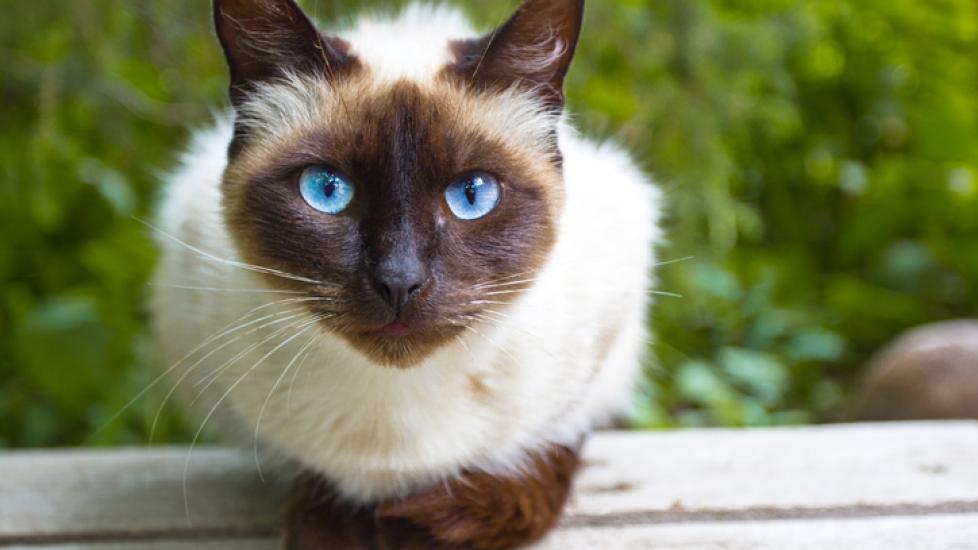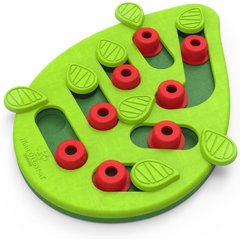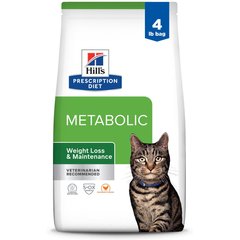Siamese Cat
Once upon a time, only royalty was permitted to keep the companionship of a Siamese cat. It was in present-day Thailand that the regal cats charmed their caregivers with stunning good looks and playful personalities. Stories of the Siamese cat say they were guardians of temples, where they were fed and cared for lavishly while protecting the souls of high-ranking people who had passed, according to the Siamese Cat Society.
Today, you don’t need royal roots to enjoy the company of this clever cat. But take note: “While gentle, Siamese cats don’t jump to mind for being laid-back,” says Annette Louviere, DVM at Wisdom Health Genetics.
Siamese cats have unique and eye-catching physical features, which have contributed to their rich history. Along with their large ears and striking baby-blue eyes, they have a slim, sleek build, with pops of dark color points on their ears, face, paws, and tail. The four traditional Siamese colors are seal, chocolate, lilac, and blue point. However, you’ll also see other color patterns, such as the tabby-coated Lynx Point Siamese.
Caring for a Siamese
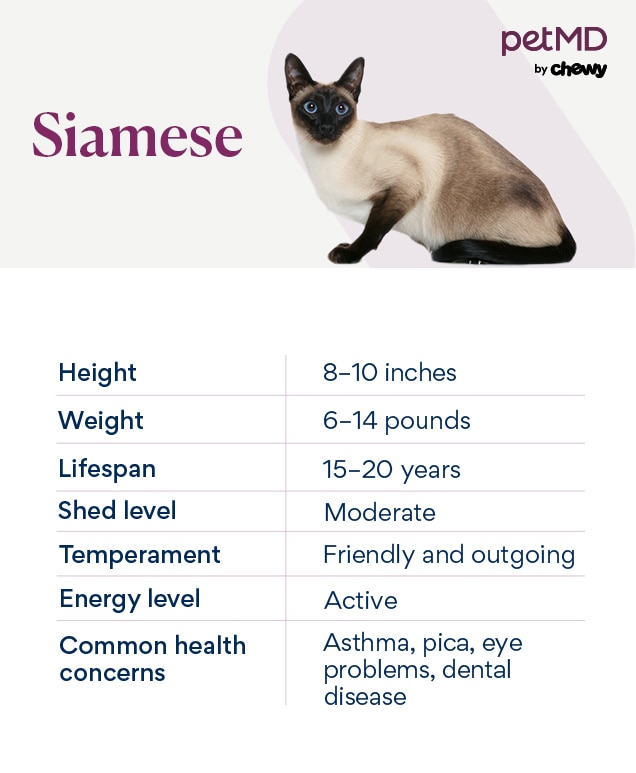
Siamese are highly intelligent and uber-playful, which means their curious antics can lead them to mischief when they’re not provided with daily enrichment. They take their need for play as seriously as their need for affection, becoming bonded and shadow-like to their human caretakers.
Adopting a Siamese cat means making time for one-on-one bonding through interactive play and training. Siamese cats are spunky, talkative, and outgoing, Louviere says. If they feel they’re not getting the attention they deserve, they’ll let you know.
Siamese Health Issues
Siamese cats have an impressive lifespan, averaging 15 years but known to live well into their 20s. Because they’re prone to some health conditions, it’s a good idea to consider purchasing pet insurance for your Siamese kitten.
Pica
Pica in cats is the tendency to eat non-food items and may be a form of compulsive behavior. According to a study published in the Journal of Veterinary Behavior, oriental cat breeds such as the Siamese are prone to pica—especially wool-sucking. Ingesting hair ties and strings is also very common and can be very serious. If your cat eats something inappropriate or stops eating their regular meals, speak with your veterinarian. Eating non-food items could result in poisoning or internal obstructions, which can be life-threatening.
Asthma
Cat asthma, like human asthma, includes symptoms such as coughing, difficulty breathing, and wheezing. While reducing dust, dander, and candles, and using special cat litter may relieve symptoms for some cats, cats with severe feline asthma may require an inhaler or lifelong oral medications.
Amyloidosis
Amyloidosis refers to a group of diseases caused by abnormal deposition of the fibrous protein amyloid into various tissues of the body. Amyloidosis disrupts the normal functions of these areas, and can lead to conditions such as liver failure and kidney disease. Siamese cats are believed to have a genetic mutation that increases their vulnerability to amyloidosis.
Hereditary Retinal Degeneration
While more frequently reported in Abyssinian and Somali cats, Siamese cats may be prone to genetic degeneration of the retina. Symptoms typically begin to appear in young cats around 1 or 2 years of age, first with night blindness and progressing to total loss of vision.
While the condition cannot be cured, cats without vision can live a full life with special considerations. Responsible Siamese breeders can and should genetically test parents for the genes.
Dental Disease
As with all cats, Siamese can develop dental disease. Brushing your cat’s teeth at home with a cat-safe toothpaste is the best way to prevent dental disease. Your veterinarian will examine your cat’s teeth yearly at their wellness exam and will recommend a dental cleaning under anesthesia when necessary.
What To Feed a Siamese
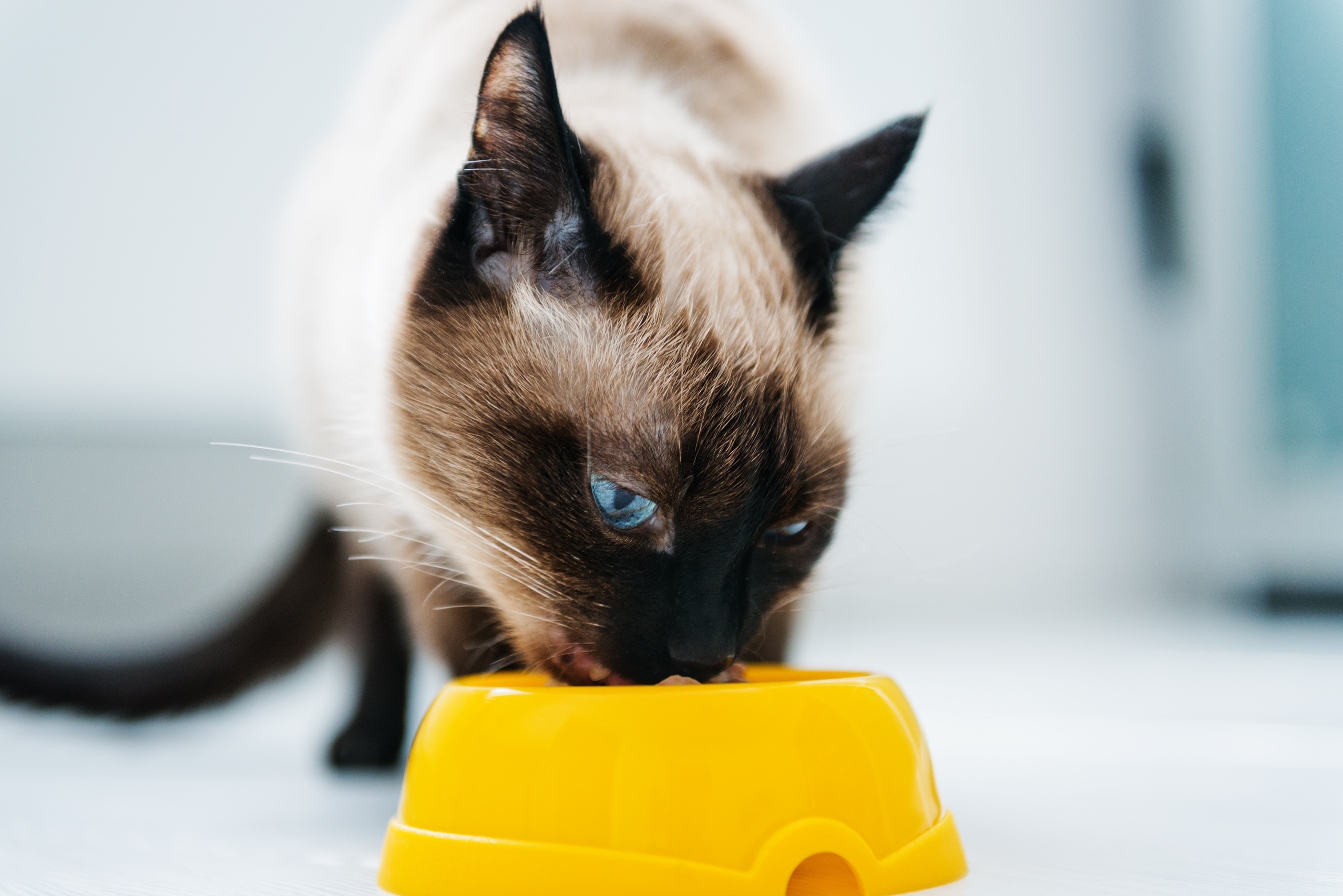
A high-quality commercial diet approved by the Association of American Feed Control Officials (AAFCO) will provide your Siamese cat with all the essential nutrients and vitamins for their life stage. It’s always best to consult your cat’s veterinarian to help make decisions on what diet is best.
How To Feed a Siamese
In the wild, cats hunt for small meals multiple times a day. So it may feel most natural to your cat to eat two or more small meals a day. Because Siamese cats are highly intelligent and crave something to do, food puzzles and lick mats can help banish mealtime boredom. Because they aren’t good at regulating food and calorie intake and tend to overeat, it’s not recommended to free-feed cats.
How Much Should You Feed a Siamese?
Siamese cats should be fed the appropriate calories based on their age, lifestyle, and ideal body condition. Your veterinarian can help determine the right amount of food for your individual cat. If your cat becomes overweight, your veterinarian may recommend a change in diet such as a reduction in calories or prescription weight-management food. Hill’s® Metabolic and Royal Canin® Satiety are both great prescription weight-loss diets for cats.
Nutritional Tips for Siamese Cats
A complete and balanced meal that meets AAFCO’s statement of nutritional adequacy will provide your cat with all essential nutrients, vitamins, fats, and proteins. In the case of health issues, your veterinarian may recommend additional nutrients.
Recommended Products
Behavior and Training Tips for Siamese Cats
Siamese Personality and Temperament
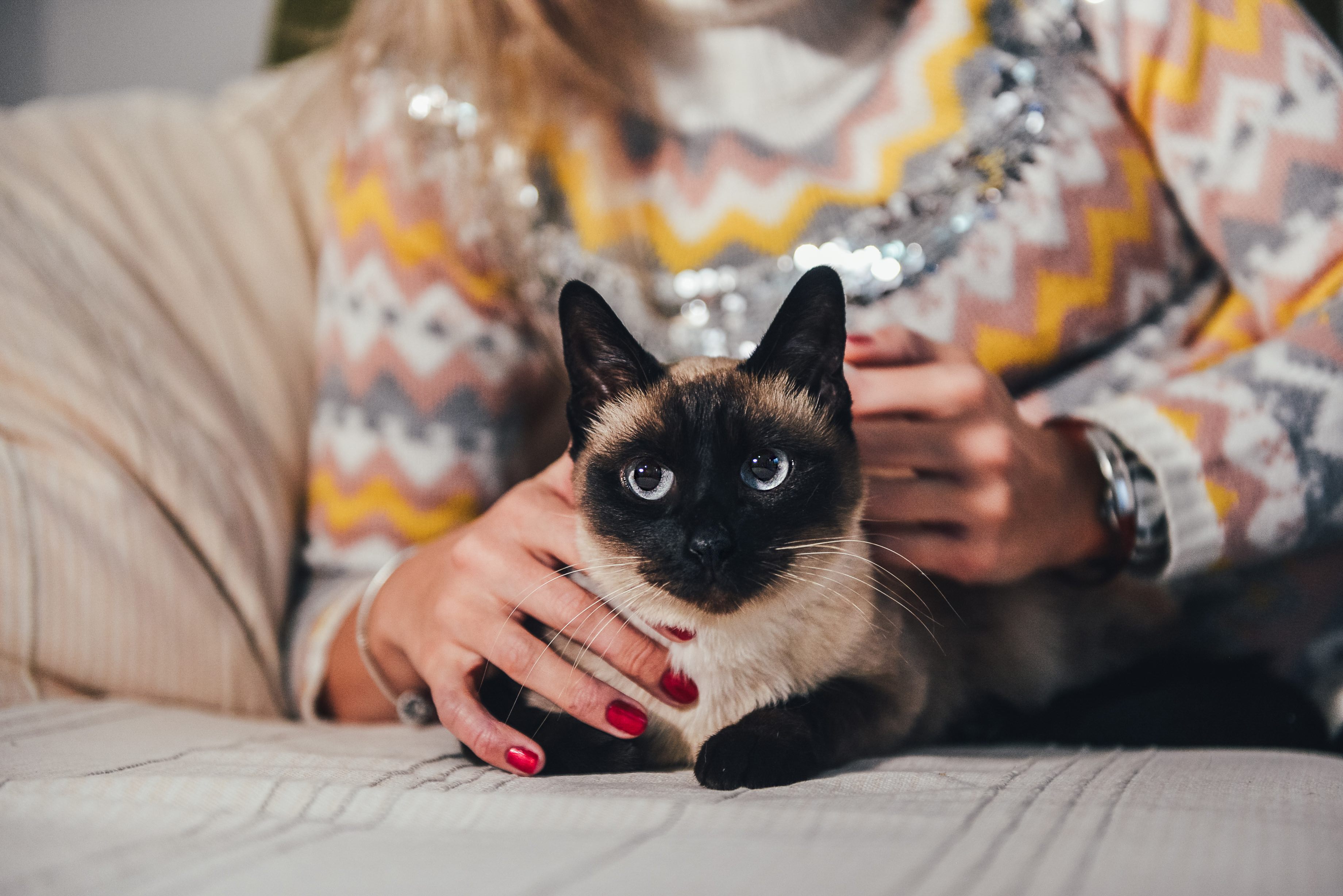
Siamese cats have a reputation for being spunky and talkative. But of course, every cat is different, says Louviere. Siamese cats can make wonderful additions for households seeking an affectionate feline with a vibrant personality, including those with kids and pups. As with any cat, introductions to other cats, dogs, and kids should be done slowly and with care.
Siamese Behavior
Early socialization is essential for any friendly feline, but Siamese cats particularly thrive with affection and attention. Although they often develop a close bond with their favorite human, don’t be surprised if you find them on your houseguest’s lap. When they’re feeling left out or just want to chat, Siamese cats will loudly meow, chip, or trill.
Siamese Training
Siamese cats are known as gentle beings, so they respond best to positive reinforcement training. They’re wicked smart and always up for engaging activities alongside their human, making them ideal candidates for harness and leash training, high fives, and other training tricks.
Fun Activities for Siamese Cats
-
Exploring on a harness and leash
-
Clicker training
-
Puzzle feeders and snuffle mats
-
Bird watching
-
Cuddles, petting, and brushing
-
Being around people
Siamese Grooming Guide
Despite their royal origins, Siamese cats don’t require any royal treatment for their skin, coat, or eyes when it comes to routine care.
Skin Care
Siamese cats don’t require special bathing or skin care. If you notice your cat is overgrooming, itching, or otherwise has skin irritation, schedule a checkup with your veterinarian.
Coat Care
Siamese cats have a short, color-pointed coat that is easy to maintain. They don’t shed excessively, but it’s a good idea to brush your cat weekly—although your attention-seeking Siamese might ask for more frequent grooming sessions. The fluffy Siamese relatives that require a little more upkeep are called Balinese.
Eye Care
Siamese cats don’t require special eye care. However, if you recognize any signs of vision loss, such as bumping into objects, talk to your veterinarian. Redness, abnormal discharge, or irritation could be a sign of a feline eye infection, which your veterinarian can treat with antibiotics.
Ear Care
Siamese cats don’t require special ear care. However, at the first sign of abnormal ear discharge, dark specks that look like coffee grounds (mites), or a foul smell from the ears, schedule a checkup with your veterinarian.
Considerations for Pet Parents
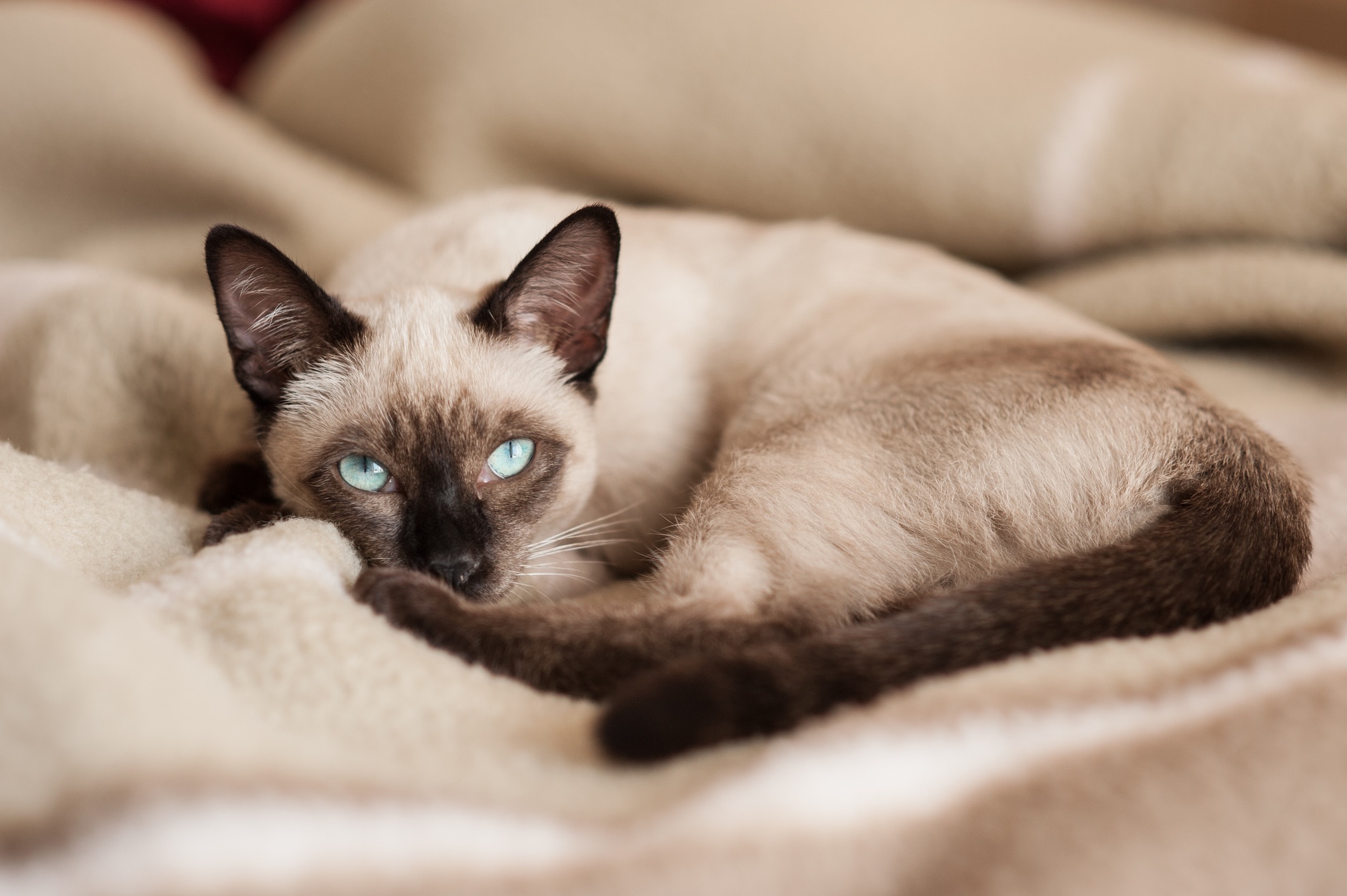
Welcoming a Siamese cat into your home means dedicating time for play and socialization. They’re often called “Velcro cats,” which means they’d rather be with their people than exercising their independence.
Providing interactive toys, food puzzles, window perches, and cat trees will reduce boredom and keep your cat happy. Although they’re suitable for apartment living, Siamese cats are chatterboxes and may meow loudly when they want attention. With appropriate care, you’ll be rewarded with a deeply loving cat that provides endless fun and energy.
Siamese Cat FAQs
Are Siamese cats hypoallergenic?
Although there is no such thing as a truly hypoallergenic cat, those with allergies can opt for cats that shed less frequently. Because Siamese cats have short fur that isn’t prone to heavy shedding, they may be a suitable choice for someone with allergies. Talk to your doctor about the best management plan for cat allergies before adopting any cat.
Is a Siamese cat a good pet?
Siamese cats make great pets for those seeking an affectionate feline with a vibrant personality. They’re gentle, and are known to get along well with both children and dogs.
Are Siamese cats cuddly?
Yes, Siamese cats love nothing more than receiving love and attention from their humans. They often form a special bond with one caregiver but will cuddle up on the lap of anyone willing.
Featured Image: iStock/chromatos
